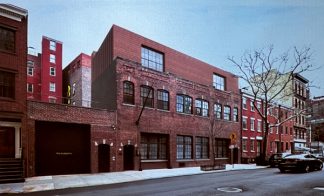Designated a historic literary site in 2014
By James V. Gambone, Ph.D.
To kick off a monthly series of short stories about Sinclair Lewis written by members of the Sinclair Lewis Society, here is what we know about Lewis’ time at 69 Charles Street, home of WestViewNews.
While living there he published his early novel Aeroplane under the pseudonym of Tom Graham.
The brownstone was Lewis’ first apartment in the Village. He came to New York after leaving what he considered a “boring job” in Washington D.C. working on a magazine for the deaf. Not a great deal is known about this early period of his life, but the people who know more than anyone else are his biographer, Richard Lingeman (Sinclair Lewis: Rebel From Main Street), Sally Parry, the Executive Director of the Sinclair Lewis Society, and Dave Simpkins, Lewis’ life-long admirer and editor of the Sauk Centre Herald for many years. Here is what these experts had to say.
Lewis was attracted to NYC and the Village because both were quickly becoming the literary centers of America. Greenwich Village was even called the “Republic of Dreams.” When he lived in the brownstone apartment, he was working as an editor at Frederick A. Stokes publishing. Lewis had worked with Stokes’ son on the Literary Review at Yale, and that was obviously a good connection. He moved in with two other Yale men, George Soule—who also worked for Stokes—and William Rose Benet, an aspiring writer and poet. Another boarder was the noted Bohemian Harry Kemp—the Hobo Poet—who made a living selling verses to various magazines.
Richard says Lewis jumped into Village life with both feet and admired celebrities who also lived there like Emma Goldman and Theodore Dreiser. However, he wasn’t really accepted in the Bohemian culture of the Village. Kemp wrote an autobiography where real people appear under fictional names. Lewis’ name was Red Flatman. In one scene, some Villagers discuss Flatman. One sniffs, “Red Flatman, though he has his qualities just doesn’t BELONG.” Another character adds, ‘”He doesn’t get us at all.” And a third chimes in: “You bet he doesn’t—strives so hard to be ‘Bohemian.” And then the character called Janice (based on the radical feminist Henrietta Rodman) drives the final nail in Red’s social coffin: “He is, and will be, to the end, I’m afraid—essentially a small-town product.” Lewis retorted that Kemp was nothing more than a “professional Bohemian.”
George Capsis for years has told the story about how Lewis had popularized the word “brunch” in New York City. The story goes that Lewis told his buddies they could save some money combining breakfast and lunch—which he called brunch—where they ate at the first outdoor café in NYC across the street from 76 Charles St. And while proud New Yorkers believe the word originated from the amazing breakfast and lunch choices after a night on the town, the word was first used in the publication Hunter’s Weekly by Guy Beringer in 1895. This is a publication Lewis would have been familiar with.
Thanks George for keeping the legacy of Sinclair Lewis alive in your paper.
If you want to know more about 69 Charles and Sinclair Lewis, please go to: english.illinoisstate.edu/sinclairlewis/the_society/documents/SLSN-Fall-14.pdf


